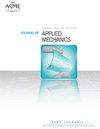Tuning buckling behaviors in magnetically active structures: topology optimization and experimental validation
IF 2.8
4区 工程技术
Q2 MECHANICS
引用次数: 1
Abstract
Buckling, a phenomenon historically considered undesirable, has recently been harnessed to enable innovative functionalities in materials and structures. While approaches to achieve specific buckling behaviors are widely studied, tuning these behaviors in fabricated structures without altering their geometry remains a major challenge. Here, we introduce an inverse design approach to tune buckling behavior in magnetically active structures through the variation of applied magnetic stimuli. Our proposed magneto-mechanical topology optimization formulation not only generates the geometry and magnetization distribution of these structures, but also informs how the external magnetic fields should be applied to control their buckling behaviors. Utilizing the proposed strategy, we discover magnetically active structures showcasing a broad spectrum of tunable buckling mechanisms, including programmable peak forces and buckling displacements, as well as controllable mechano- and magneto-induced bi-stability. Furthermore, we experimentally demonstrate that multiple unit designs can be assembled into architectures, resulting in tunable multi-stability and programmable buckling sequences under distinct applied magnetic fields. Employing a hybrid fabrication method, we manufacture and experimentally validate the generated designs and architectures, confirming their ability to exhibit precisely programmed and tunable buckling behaviors. This research contributes to the advancement of multifunctional materials and structures that harness buckling phenomena, unlocking transformative potential for various applications, including robotics, energy harvesting, and deployable & reconfigurable devices.磁活性结构屈曲行为的调谐:拓扑优化和实验验证
屈曲,一种历史上被认为是不受欢迎的现象,最近被用来实现材料和结构的创新功能。虽然实现特定屈曲行为的方法得到了广泛的研究,但在不改变预制结构几何形状的情况下调整这些行为仍然是一个主要挑战。在这里,我们介绍了一种逆设计方法,通过改变外加磁刺激来调整磁活性结构的屈曲行为。我们提出的磁力学拓扑优化公式不仅生成了这些结构的几何形状和磁化分布,而且还告诉我们应该如何施加外部磁场来控制它们的屈曲行为。利用提出的策略,我们发现磁活性结构具有广泛的可调屈曲机制,包括可编程的峰值力和屈曲位移,以及可控的机械和磁致双稳定性。此外,我们通过实验证明,多个单元设计可以组装成结构,从而在不同的外加磁场下产生可调谐的多稳定性和可编程的屈曲序列。采用混合制造方法,我们制造并实验验证了生成的设计和结构,确认了它们具有精确编程和可调屈曲行为的能力。这项研究有助于利用屈曲现象的多功能材料和结构的进步,释放各种应用的变革潜力,包括机器人,能量收集和可部署和可重构设备。
本文章由计算机程序翻译,如有差异,请以英文原文为准。
求助全文
约1分钟内获得全文
求助全文
来源期刊
CiteScore
4.80
自引率
3.80%
发文量
95
审稿时长
5.8 months
期刊介绍:
All areas of theoretical and applied mechanics including, but not limited to: Aerodynamics; Aeroelasticity; Biomechanics; Boundary layers; Composite materials; Computational mechanics; Constitutive modeling of materials; Dynamics; Elasticity; Experimental mechanics; Flow and fracture; Heat transport in fluid flows; Hydraulics; Impact; Internal flow; Mechanical properties of materials; Mechanics of shocks; Micromechanics; Nanomechanics; Plasticity; Stress analysis; Structures; Thermodynamics of materials and in flowing fluids; Thermo-mechanics; Turbulence; Vibration; Wave propagation

 求助内容:
求助内容: 应助结果提醒方式:
应助结果提醒方式:


